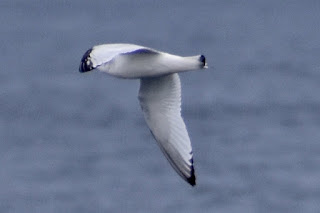Glaucous Gull and Eared Grebe - 1/22 & 1/23

On Sunday afternoon I took my wife for a ride to Island Beach State Park. Except for an abundance of common loons and a half dozen razorbills, it was a blasé day for birding along the beach. However, a little change up greeted us when we reached the beach end at the inlet jetty. A couple hundred gulls, mostly herring, gathered there, many on the water and many on the jetty. Almost immediately, I spotted an all-white gull, amongst the white-and-gray gulls, sitting on the water near the jetty. I pointed it out to my wife and then identified it as a Glaucous gull . I explained to her that it was one of the two white-winged gull species that can show up this time of year, the other being Iceland gull . I pointed out the difference that these gulls lack the black wing tips that all the other gulls around us had. It was 13 months since I last saw a Glaucous gull. My wife was with me that day too when we saw one flying along the beach in nearly the same spot. Juvenile glaucous g


